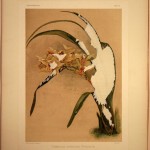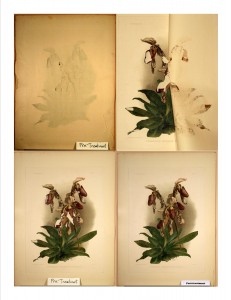Extreme Makeover: Reichenbachia, Imperial Edition
Text & Photos by Erica Borey, VCU Museum Studies Intern, Lewis Ginter Botanical Garden
As you may have read in our early summer blog post on Reichenbachia, Lewis Ginter Botanical Garden holds one of the only known copies of the Imperial Edition of Reichenbachia, a collection of late-19th-century chromolithographs depicting various orchid specimens. Unfortunately, due to years of poor storage conditions many of these prints were either partially or completely hidden beneath a layer of paper. Pressure and moisture over the years caused many of the prints’ cover sheets to stick to certain inks in the images, resulting in images like Cymbidium winnianum, right:
After transferring each print to a more stable housing environment designed to prevent further degradation, I was trained by a local paper conservator on how to lift the adhered paper with minimal disturbance to the ink beneath, thus revealing their original gorgeous faces. One by one, I carefully and slowly uncovered each of the compromised images. In some cases, the paper adhesion was minor and the treatment was fast. Others, as in the photo above, required a time commitment of several hours -– sometimes days! However long it took, each newly uncovered orchid reinforced my desire to restore the visibility of this collection in its entirety. Over the summer I completed this process of restoration on 89 of the 192 prints in the collection! Please enjoy a selection of prints before and after their conservation in the following slideshow!
Special thanks are due to the collection’s donor, Dr. Arthur Burke, who exceeded the generosity of his original donation by also providing the means for me to conserve them. Now that the most obvious damage to this collection has been addressed, I turn to another common problem: many are also torn. Aged paper can be very delicate, and the majority of this collection has sustained some degree of tearing. I’ve already undergone conservator training to mend and stabilize tears, which will increase each print’s durability, especially useful if and when they are put on display. Thanks to a graduate assistantship, I am able to carry on my work with this collection for the 2012-2013 school year. I look forward to improving the condition of this rare and outstanding example of botanical artwork so that it may someday be displayed for an art and orchid-loving public. After all, what is the use of conserving a historically and aesthetically unique print collection if no one gets to see it? If you’d like to come see a few selections, you can contact the Lora Robins Library.
For further reading:
Alrich, Peggy A. and Wesley E. Higgins. “Reichenbachia: The Story of a Masterpiece and the People” in Orchids: The Bulletin of the American Orchid Society 79 (July 2010) 392-401.

